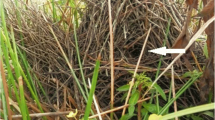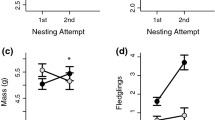Summary
-
1.
Several probability models are used to examine the hypothesis that mud-nesting Hymenoptera include empty, yet sealed, cells in their nests to reduce the success of parasites that break into the nest after its completion and destroy the immature host therein. We examine optimal empty cell placement when parasites choose cells randomly and abandon a host nest after encountering one or two consecutive empty cells. We also consider cases in which parasites begin hunting (1) randomly, or (2) peripherally and then proceed unidirectionally until either all nest cells have been parasitized or two consecutive empty cells have been encountered.
-
2.
In all cases the host may increase net reproductive output by appropriate placement of empty cells. Parasites may combat empty cell placement by hosts by evolving a persistent, random search hunting method.
-
3.
The literature on empty cell inclusion in mud nests is examined, and one tentative case, that of Pseudomasaris vespoides (Cress.), is discussed.
Similar content being viewed by others
References
Edmunds, M.: Defence in animals. New York: Longman 1974
Evans, H.E.: The comparative ethology and evolution of the sand wasps. Cambridge, Massachusetts: Harvard Univ. 1966a
Evans, H.E.: The behavior patterns of solitary wasps. Annu. Rev. Entomol. 11, 123–154 (1966b)
Evans, H.E.: Extrinsic versus intrinsic factors in the evolution of insect sociality. BioScience 27, 613–617 (1977)
Evans, H.E., West Eberhard, M.J.: The wasps. Ann Arbor, Michigan: Univ. Michigan 1970
Guenther, W.C.: The inverse hypergeometric — a useful model. Statistica Neerlandica 29, 129–144 (1975)
Hicks, C.H.: Pseudomasaris vespoides (Cresson), a pollen provisioning wasp. Can. Entomol. 59, 75–79 (1927)
Hicks, C.H.: Pseudomasaris edwardsii (Cresson). Another pollen-provisioning wasp, with further notes on P. vespoides (Cresson). Can. Entomol. 61, 121–125 (1929)
Hungerford, H.B.: Pseudomasaris occidentalis (Cresson) in Kansas (Hymenoptera-Vespidae). J. Kans. Entomol. Soc. 10, 133–134 (1937)
Janvier, H.: Etude biologique de quelques Hyménoptères du Chili. Ann. Sci. Nat. Zool. Biol. Anim. 16, 209–356 (1933)
Krombein, K.V.: Trap-nesting wasps and bees. Life histories, nests and associates. Washington, D.C.: Smithsonian 1967
Levins, R.: Evolution in communities near equilibrium. In: Ecology and evolution of communities. Cody, M.L., Diamond, J.M. (eds.), pp. 16–50. Cambridge, Massachusetts: Belknap 1975
Linsley, E.G.: The ecology of solitary bees. Hilgardia 27, 543–599 (1958)
Malyshev, S.I.: The nesting habits of solitary bees. Eos 11, 201–309 (1935)
Parker, F.D.: Notes on the nests of three species of Pseudomasaris Ashmead (Hymenoptera: Masaridae). Pan-Pac. Entomol. 43, 213–216 (1967)
Pyke, G., Pulliam, H.R., Charnov, E.L.: Optimal foraging, a selective review of theory and tests. Q. Rev. Biol. 52, 137–154 (1977)
Rau, P.: Field studies in the behavior of the non-social wasps. Trans. Acad. Sci. St. Louis 25, 325–489 (1928)
Rau, P., Rau, N.: The biology of the mud-daubing wasps as revealed by the contents of their nests. J. Anim. Behav. 6, 27–63 (1916)
Stephen, W.P., Bohart, G.E., Torchio, P.F.: The biology and external morphology of bees. Corvallis, Oregon: Oreg. State Univ. Agric. Exp. Stat. 1969
Author information
Authors and Affiliations
Rights and permissions
About this article
Cite this article
Tepedino, V.J., McDonald, L.L. & Rothwell, R. Defense against parasitization in mud-nesting Hymenoptera: Can empty cells increase net reproductive output?. Behav Ecol Sociobiol 6, 99–104 (1979). https://doi.org/10.1007/BF00292555
Received:
Accepted:
Issue Date:
DOI: https://doi.org/10.1007/BF00292555




